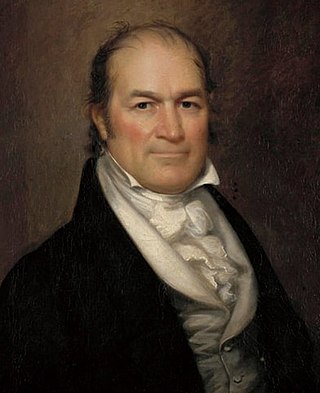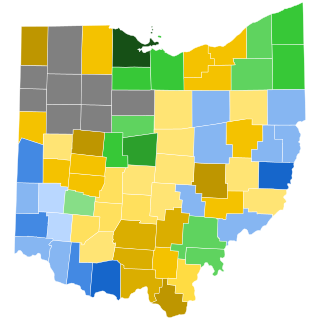
The 1824 United States presidential election was the tenth quadrennial presidential election. It was held from Tuesday, October 26 to Thursday, December 2, 1824. Andrew Jackson, John Quincy Adams, Henry Clay and William Crawford were the primary contenders for the presidency. The result of the election was inconclusive, as no candidate won a majority of the electoral vote. In the election for vice president, John C. Calhoun was elected with a comfortable majority of the vote. Because none of the candidates for president garnered an electoral vote majority, the U.S. House of Representatives, under the provisions of the Twelfth Amendment, held a contingent election. On February 9, 1825, the House voted to elect John Quincy Adams as president, ultimately giving the election to him.

The 1828 United States presidential election was the 11th quadrennial presidential election. It was held from Friday, October 31 to Tuesday, December 2, 1828. It featured a repetition of the 1824 election, as President John Quincy Adams of the National Republican Party faced Andrew Jackson of the Democratic Party. Both parties were new organizations, and this was the first presidential election their nominees contested. This election saw the second rematch in presidential history, something that would not occur again until 1840.

The 1832 United States presidential election was the 12th quadrennial presidential election, held from Friday, November 2 to Wednesday, December 5, 1832. Incumbent president Andrew Jackson, candidate of the Democratic Party, defeated Henry Clay, candidate of the National Republican Party.

William Harris Crawford was an American politician and judge during the early 19th century. He served as US Secretary of War and US Secretary of the Treasury before he ran for US president in the 1824 election.

The presidency of John Quincy Adams, began on March 4, 1825, when John Quincy Adams was inaugurated as President of the United States, and ended on March 4, 1829. Adams, the sixth United States president, took office following the 1824 presidential election, in which he and three other Democratic-Republicans—Henry Clay, William H. Crawford, and Andrew Jackson—sought the presidency. Adams was not a strong president, and he was under continuous attack from Jackson who easily defeated him in the 1828 presidential election.

In Missouri, the 1824 United States presidential election resulted in the state's electoral college votes going to Henry Clay, but then its vote in the House of Representatives contingent election going to the eventual winner, John Quincy Adams. In the 1824 presidential election, five major candidates emerged: Clay, Adams, Andrew Jackson, William H. Crawford, and John C. Calhoun, although Calhoun dropped out to run for the vice presidency. In the new state of Missouri, Crawford had little support, Clay was the popular favorite, Jackson was popular in rural areas, and Adams had some support in urban areas, particularly St. Louis. Clay won the popular vote, with Jackson second, Adams third, and Crawford fourth, and Clay received Missouri's three votes in the electoral college.

The 47th New York State Legislature, consisting of the New York State Senate and the New York State Assembly, met from January 6 to November 27, 1824, during the second year of Joseph C. Yates's governorship, in Albany.

The 1824 United States presidential election in Connecticut took place between October 26 and December 2, 1824, as part of the 1824 United States presidential election. Voters chose eight representatives, or electors to the Electoral College, who voted for President and Vice President.

The 1824 United States presidential election in Illinois took place between October 26 and December 2, 1824, as part of the 1824 United States presidential election. Voters chose three representatives, or electors to the Electoral College, who voted for President and Vice President.

The 1824 United States presidential election in Maryland took place between October 26 and December 2, 1824, as part of the 1824 United States presidential election. Voters chose 11 representatives, or electors to the Electoral College, who voted for President and Vice President.

The 1824 United States presidential election in North Carolina took place between October 26 and December 2, 1824, as part of the 1824 United States presidential election. Voters chose 15 representatives, or electors to the Electoral College, who voted for President and Vice President.

The 1824 United States presidential election in Ohio took place between October 26 and December 2, 1824, as part of the 1824 United States presidential election. Voters chose 16 representatives, or electors to the Electoral College, who voted for President and Vice President.

The 1824 United States presidential election in Virginia took place between October 26 and December 2, 1824, as part of the 1824 United States presidential election. Voters chose 24 representatives, or electors to the Electoral College, who voted for President and Vice President.

The 1824 United States presidential election in New York took place between October 26 and December 2, 1824, as part of the 1824 United States presidential election. The state legislature chose 36 representatives, or electors to the Electoral College, who voted for President and Vice President.

The 1828 United States presidential election in Georgia took place on November 3, 1828, as part of the 1828 United States presidential election. Georgia voters chose 9 electors to the Electoral College, who voted for president and vice president.

The 1824 United States elections elected the members of the 19th United States Congress. It marked the end of the Era of Good Feelings and the First Party System. The divided outcome in the 1824 presidential contest reflected the renewed partisanship and emerging regional interests that defined a fundamentally changed political landscape. The bitterness that followed the election ensured political divisions would be long-lasting and facilitated the gradual emergence of what would eventually become the Second Party System. Members of the Democratic-Republican Party continued to maintain a dominant role in federal politics, but the party became factionalized between supporters of Andrew Jackson and supporters of John Quincy Adams. The Federalist Party ceased to function as a national party, having fallen into irrelevance following a relatively strong performance in 1812.

In 1828, Andrew Jackson, who had lost the 1824 election in a runoff in the United States House of Representatives, despite winning both the popular vote and the electoral vote by significant margins, ran for President of the United States. He had been nominated by the Tennessee state legislature in 1825, and did not face any opposition from Democratic candidates. Jackson launched his campaign on January 8, 1828, with a major speech on the 13th anniversary of the Battle of New Orleans from 1815, thus marking the birth of the modern Democratic Party. Jackson accepted John C. Calhoun, incumbent vice president under John Quincy Adams, as his running mate.
In the United States, a contingent election is used to elect the president or vice president if no candidate receives a majority of the whole number of Electors appointed. A presidential contingent election is decided by a special vote of the United States House of Representatives, while a vice-presidential contingent election is decided by a vote of the United States Senate. During a contingent election in the House, each state delegation votes en bloc to choose the president instead of representatives voting individually. Senators, by contrast, cast votes individually for vice president.

American politician John Quincy Adams served as President of the United States (1825–1829) and United States Secretary of State (1817–1825). Prior to being president, he had served as United States Senator from Massachusetts (1803–1808) and had diplomatic experience as United States Minister to United Kingdom (1815–1817), Russia (1809–1814), Prussia (1797–1801) and the Netherlands (1794–1797). After losing the 1828 presidential election, he served as a member of the U.S. House of Representatives from Massachusetts for 17 years. He is the only American president to be elected to the House of Representatives after leaving office.


















